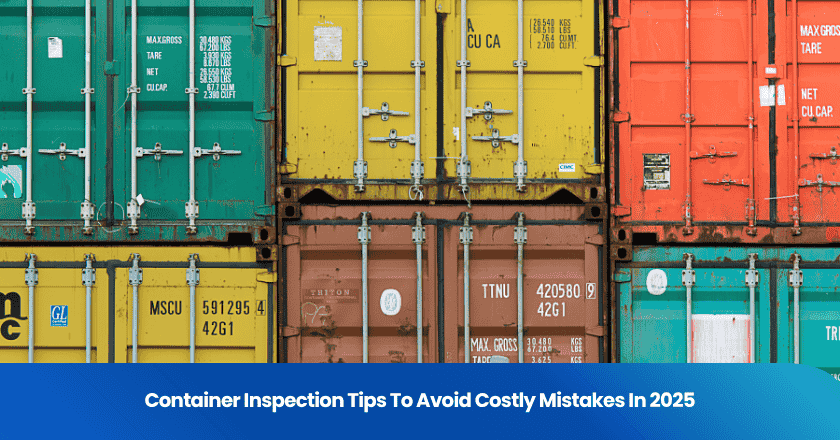
You face increasing pressure to prevent costly recalls and maintain product quality as global shipping container volumes surge. Skipping thorough container inspection or neglecting pre-shipment inspections can lead to container damage, common types of damage, and even regulatory fines. Proactive quality control not only reduces risks but also delivers real business value.
Inspections help you spot issues before they escalate, saving time, money, and reputation.
Why container inspection matters
Cost and risk factors
You face significant risks every time you load a shipping container for international transport. Container inspection plays a crucial role in protecting your cargo and your bottom line. When you conduct thorough inspections, you reduce the chance of safety hazards that can lead to cargo loss, delays, or even legal trouble.
Consider the main reasons inspections matter:
| Reason for Inspection | Explanation |
|---|---|
| Structural Integrity | Ensures containers are free from damage that could compromise safety during transit. |
| Compliance with Regulations | Validates adherence to international shipping standards, preventing legal issues. |
| Minimizing Liability | Reduces the risk of financial loss due to damage or loss of cargo during shipping. |
Pre-shipment inspections help you spot safety hazards before they become expensive problems. If you miss a damaged door or a faulty seal, you risk exposing your goods to water, pests, or theft. These issues can quickly escalate, leading to higher insurance premiums and operational setbacks. In fact, damaged containers contribute to about 1,582 lost containers at sea each year, causing both financial and environmental harm. Delays from container damage also disrupt your shipping schedule and reduce efficiency.
Impact of missed issues
Missing key issues during container inspection can have a domino effect on your operations. You may face delays that result in accumulating fees and missed delivery windows. These setbacks often lead to increased costs from demurrage, detention, and unnecessary trucking. Your customer relationships can suffer if late shipments damage trust or cause chargebacks. Safety hazards, such as structural weaknesses or contamination, put your team and cargo at risk. Outdated or incomplete inspections can also waste resources by forcing you to reschedule labor or equipment.
Tip: Use a checklist for every shipping container to catch safety hazards early and avoid costly mistakes.
Regular inspections protect your business from unexpected expenses and help you maintain a strong reputation in the logistics industry.
Top 10 common issues in container inspection
Structural defects
You need to pay close attention to structural defects during every container inspection. These defects include cracks, dents, warping, and weakened corner castings. Overloading a shipping container often causes permanent damage and compromises its structural integrity. Exceeding the maximum gross weight of 30,480 kg for a standard 20-foot container can lead to failed inspections, operational delays, and safety hazards. The CSC plate on each container certifies compliance with international safety standards, but regular reinspection every 30 months is necessary to maintain certification.
Spotting structural defects early helps you avoid costly repairs and shipment delays. Always check for visible damage, especially after severe weather or modifications. Prevent overloading by verifying cargo weights before loading.
Door and lock failures
Door and lock failures are among the most common defects found during pre-shipment inspections. Damaged or malfunctioning doors can lead to theft, cargo loss, and regulatory penalties. You should look for signs of rust, leaks, or tampering around the locking mechanisms. Upgrading to advanced locking systems, such as internal locks or smart locks, increases security. Regular monthly inspections and seasonal maintenance help you catch problems early. Replace outdated locks and apply fresh coatings to prevent rust and moisture buildup.
- Use advanced locking systems for better security.
- Inspect doors and locks monthly for rust, leaks, or tampering.
- Perform seasonal maintenance to address moisture and rust.
- Upgrade old locks to modern, high-security options.
Water leaks and moisture
Water leaks and moisture problems can ruin cargo and create hazardous conditions inside a shipping container. About 11% of containers inspected in 2024 had safety deficiencies, with water intrusion as a leading cause. You should check for condensation line blockages, clogged air filters, inadequate insulation, damaged drain pans, and high humidity. These issues often result in dampness, mold, and corrosion.
- Inspect condensate lines and air filters regularly.
- Ensure proper insulation on ducts.
- Repair or replace damaged drain pans.
- Monitor humidity levels inside containers.
Corrosion and rust
Corrosion and rust are persistent threats to container safety. You can identify rust by looking for flaking paint, bubbling, or reddish-brown spots, especially around edges and corners. Regular inspections every few months help you catch early signs of wear. Clean affected areas with a wetting agent, scrub with a wire brush, and repaint with a corrosion-resistant sealant. Wash off debris and salt buildup to prevent further damage.
- Inspect for rust and corrosion, especially near doors and roofs.
- Apply protective coatings and ensure proper drainage.
- Treat rust-prone areas immediately after detection.
Floor damage
Floor damage is a frequent issue in container inspection. Heavy loads, improper packing, and moisture exposure can cause cracks, warping, or rot in the wooden flooring. Damaged floors may lead to cargo instability and increase the risk of accidents. Always check for soft spots, splinters, or signs of water damage during pre-shipment inspections. Prevent floor defects by distributing weight evenly and using pallets or dunnage to protect the surface.
Poor ventilation
Poor ventilation leads to a range of common defects, including water damage, mold, and corrosion. When air cannot circulate, condensation forms and damages stored goods. Mold and mildew thrive in humid conditions, ruining textiles and paper products. Corrosion shortens the lifespan of tools and machinery. Musty odors and pest infestations often follow poor ventilation.
- Ensure vents are clear and functional.
- Use desiccants or dehumidifiers to control moisture.
- Regularly inspect for signs of dampness or mold.
Contamination and residue
Contamination and residue pose serious health and environmental risks. Residues from pesticides or chemicals can linger in containers, leading to neurological disorders, metabolic diseases, and increased risks for vulnerable populations. Contaminated containers may leach harmful substances into soil and water, affecting drinking supplies and aquatic life. Direct exposure can cause dizziness and nausea, while long-term exposure links to cancers and reproductive issues.
- Clean containers thoroughly after each use.
- Avoid burning empty chemical containers.
- Use protective equipment when handling potentially contaminated containers.
Faulty seals and gaskets
Faulty seals and gaskets allow water, dust, and pests to enter the shipping container, causing cargo damage and contamination. You can spot these defects by looking for visible fluid leaks, vibration, degraded material, or dirt accumulation around seals. Pressure loss or performance changes also indicate seal failure. Regularly inspect seals for damage or wear, and use pressure testing to identify leaks. Replace damaged seals and ensure proper installation practices.
1. Visually inspect seals for damage.
2. Test for leaks using pressure methods.
3. Evaluate environmental conditions for compatibility.
4. Replace worn or incompatible seals promptly.
Documentation and placarding issues
Documentation and placarding issues account for nearly half of all deficiencies found during container inspections. Incomplete or incorrect paperwork, missing labels, and improper placarding can lead to shipment delays, fines, and regulatory penalties. Electronic dangerous goods declarations and automated labeling systems help reduce these common defects. Always verify that all documents and placards meet regulatory requirements before shipping.
- Check all documentation for accuracy and completeness.
- Use electronic systems to streamline labeling and recordkeeping.
- Ensure placards are visible and compliant with regulations.
Pest and mold problems
Pest and mold problems are common defects that threaten cargo safety and quality. Mold grows rapidly in humid, poorly ventilated containers, while pests such as insects and rodents damage goods and packaging. You can prevent these issues by controlling temperature and humidity, ensuring good air circulation, and cleaning storage areas thoroughly. Use fungicides only as a last resort and always follow safety guidelines.
- Control temperature and humidity to prevent mold.
- Maintain good air circulation in storage areas.
- Clean containers and storage materials regularly.
Tip: Addressing these common defects during pre-shipment inspections helps you avoid costly mistakes, regulatory risks, and customer complaints. A proactive approach to container inspection protects your cargo, reputation, and bottom line.
Common defects and inspection checklist
Key inspection points
You need a systematic approach to container inspection to catch defects before they impact your shipment. Focus on these essential steps during pre-shipment inspections:
- Conduct a visual exterior check monthly.
- Review the interior every 3–6 months.
- Schedule a full inspection annually.
- Inspect immediately after modifications or severe weather.
- Examine the floor for damage.
- Check seal integrity and paint condition.
- Test door functionality and locking mechanisms.
- Verify the ISO identification and CSC plate.
- Use the 7-point technique for a thorough visual review.
- Confirm shipping documents match the cargo.
Tip: Ventilate the shipping container for at least two hours and sweep the interior to prevent moisture-related issues.
Staff training tips
You strengthen your inspection process by preparing your team. Assign responsibilities for regular inspections to ensure accountability. Use mobile platforms to deliver training in short, focused lessons. Encourage post-incident inspections to help staff recognize defects and prevent major issues.
Using technology
Modern technology improves the accuracy of container inspection and helps you detect defects quickly. Deep learning models like YOLO-NAS and CNNs process visual data, identifying complex damage patterns. Object detection systems enable rapid assessments, reducing manual errors.
Maintenance scheduling
You reduce the risk of defects and inspection failures by optimizing maintenance. Predictive maintenance uses sensor data to anticipate equipment problems. Condition-based scheduling relies on actual container conditions instead of fixed intervals. Advanced AI analyzes performance data and recommends timely interventions.
Tracking inspection results
You improve future inspections by tracking and analyzing results. Implement centralized logging to aggregate inspection data. Set thresholds and alerts to identify issues quickly. Monitor key performance metrics to maintain shipping container health and prevent recurring defects.
You protect your business when you prioritize container inspection and stay alert to common issues. Proactive pre-shipment inspections help you avoid costly mistakes and keep every shipping container safe. Regular inspections deliver real benefits:
- Ensuring cargo safety and integrity prevents damage and loss.
- Preventing unauthorized access and tampering reduces theft and smuggling risks.
- Maintaining ISO and regulatory compliance avoids fines and shipment rejections.
- Reducing financial and operational risks leads to smoother operations.
You should use the checklist and tips for every shipment. Make container inspection a critical part of your logistics process to reduce issues and protect every shipping container.
FAQ
What is the most important step in a shipping container inspection?
You should always start with a thorough visual check. Look for structural damage, rust, and water leaks. This first step helps you identify obvious problems before you load any cargo.
How often should you inspect a shipping container?
You need to inspect each shipping container before every use. Schedule full inspections annually and after severe weather events. Regular checks help you catch issues early and avoid costly repairs.
What tools do you need for a proper inspection?
You should use a flashlight, inspection mirror, moisture meter, and a checklist. These tools help you spot hidden defects and ensure you do not miss any critical inspection points.
Can technology improve the inspection process?
Yes. Digital inspection apps and AI-powered image analysis help you detect defects faster and more accurately. These tools also make it easier to track inspection results over time.
What should you do if you find mold or pests inside a container?
Remove all cargo immediately. Clean and disinfect the container thoroughly. Improve ventilation and control humidity to prevent future infestations.
Grow your business with TradeAider Service
Click the button below to directly enter the TradeAider Service System. The simple steps from booking and payment to receiving reports are easy to operate.


